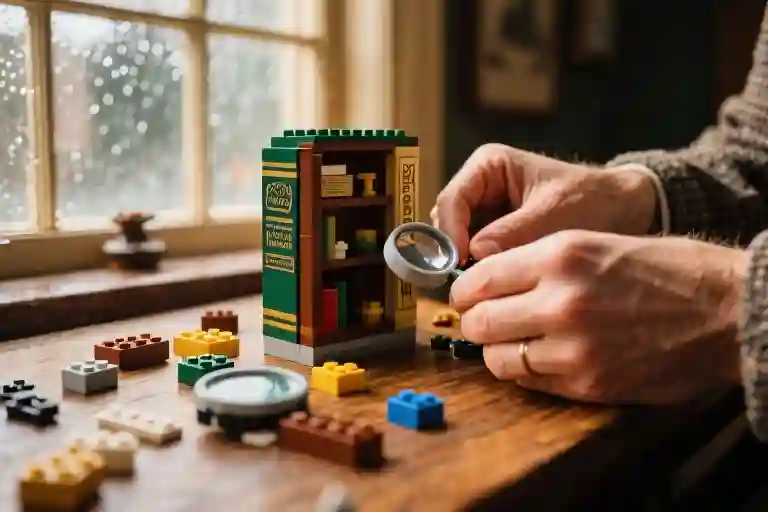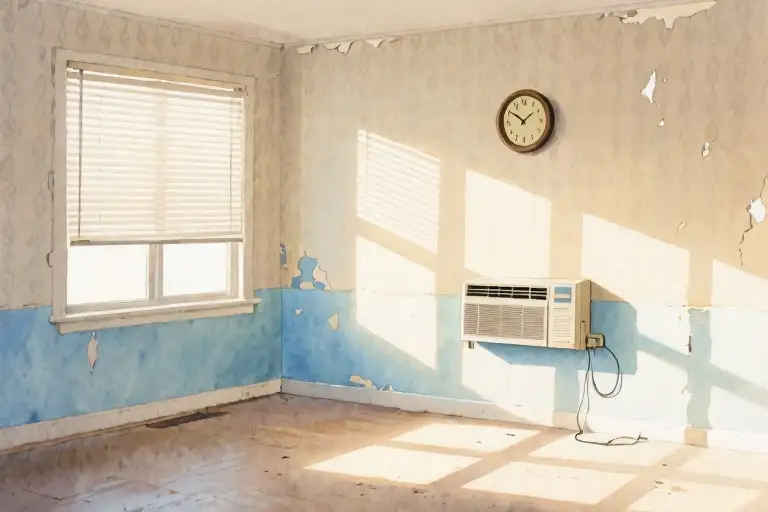The glass of iced black tea sweats in the afternoon humidity, its condensation tracing slow paths down the surface while raindrops tap irregular rhythms against the windowpane. Somewhere between the third irregular drip from the leaking gutter and the fifth sip of tannin-bitter tea, my fingers betray their original assignment – quarterly reports spread across the desk, cursor blinking impatiently on an unfinished spreadsheet – and reach instead for the cardboard box that arrived three days prior.
Sherlock Holmes: Book Nook. 478 pieces of ABS plastic promising Victorian intrigue packaged in a deceptively small rectangle. The sound of bricks pouring onto the wooden tabletop creates a peculiar counterpoint to the rain’s percussion, like a staccato orchestra tuning up before some grand cognitive performance. I should feel guilty about this diversion, about the way my thumb hesitates over the box flap knowing full well about the unfinished work just inches away. But there’s something medicinal in the way the LEGO logo stares back at me, its primary colors clashing wonderfully with the grey afternoon.
Adult life rarely accommodates these small rebellions, these deliberate pauses where plastic bricks outweigh professional responsibilities. Yet here I am, carefully separating bagged components while the tea grows tepid, the rain providing both soundtrack and excuse. The instruction manual falls open to reveal STEP 1, its cheerful diagrams somehow more compelling than any corporate flowchart. That first snap of two bricks connecting carries surprising finality – the decision point crossed, the quarterly reports officially dethroned.
What follows isn’t just assembly but archaeology, each printed tile and specialty piece excavating memories I hadn’t realized were buried. The magnifying glass element (part 30242, my fingers note automatically) winks up from the sorting tray, its transparent orange lens warping the wood grain beneath. Some dormant part of my brain whispers about Arthur Conan Doyle’s description of Holmes’ glass in A Study in Scarlet, while another insists this exact piece once formed part of a childhood spaceship. The dichotomy makes me smile – how these molded plastic studs become both time machine and Rorschach test.
Outside, the rain intensifies, its white noise blending with the tactile symphony of brick separation and connection. There’s rhythm to this process, a kind of manual meditation where the repetitive motions of following diagrams somehow untangle mental knots no spreadsheet ever could. I catch myself holding my breath during particularly precise placements – the tiny violin piece balanced on the bookshelf, the microscopic newspaper clipping inserted just so – realizing with quiet amusement that my concentration here surpasses anything I’ve mustered for actual work in weeks.
Halfway through bag two, when the bookcase structure begins taking recognizable shape, something unexpected happens. The plastic bricks stop being simple components and start telling stories beyond their intended narrative. The brown tiles meant to represent wood grain suddenly evoke my grandmother’s attic trunk; the deep red slope pieces recall long-ago Christmas mornings. It’s not nostalgia so much as recollection through fingertips, memories encoded in the particular resistance between clutch power and separation force.
By the time the miniature gas lamp clicks into place atop the assembled book nook, the rain has slowed to a drizzle. Golden hour light slants through the window, making the translucent flame element glow as if lit from within. For a suspended moment, the plastic diorama breathes – Baker Street in microcosm, yes, but also something more personal. That elusive satisfaction of creation mixes with the melancholy of completion, the bittersweet awareness that this precise configuration of thoughts and bricks will never quite recur.
The quarterly reports still wait, of course. The cursor still blinks. But something has shifted in the afternoon’s economy – not escape, but recalibration. There’s therapy in these plastic bricks, though not the sort marketed in mindfulness journals. It’s the kind that comes from letting your hands remember what your mind has forgotten: that focus can be playful, that creation needn’t always be productive, and that sometimes the most adult thing you can do is build something utterly unnecessary, just because it brings you quiet joy.
When a Detective Drama Fan Meets LEGO Instructions
The box arrived with that distinctive rattle of plastic bricks shifting inside cardboard, a sound that never fails to trigger a Pavlovian response in any AFOL (Adult Fan of LEGO). What surprised me was how the packaging itself became the first clue in this building mystery – the brown kraft paper box printed with faux-newspaper headlines straight out of The Strand Magazine circa 1891. LEGO designers had embedded their first Easter egg before I’d even broken the seal.
Peeling back the layers revealed more Victorian-era touches. Instruction booklet #1 featured margins filled with handwritten case notes mimicking Dr. Watson’s journals. The part that truly arrested my attention was Element 30242 – the magnifying glass piece. Its hexagonal handle precisely matched the illustration in “A Scandal in Bohemia,” that iconic moment when Holmes demonstrates his observational prowess to the baffled king. Holding this tiny plastic replica, I realized LEGO wasn’t just selling building blocks; they were packaging forensic attention to detail.
Then came the delightful cognitive dissonance of modern injection-molded plastic recreating 19th-century artifacts. The tobacco pipe element (Part 6241875) presented a particular design challenge – how to render Holmes’ curved meerschaum in LEGO’s angular language. The solution? A clever repurposing of the classic wand piece with a modified stem. Side-by-side with Sidney Paget’s original illustrations, this abstraction somehow captured the essence while remaining unmistakably LEGO.
What began as simple construction revealed itself as cultural archaeology. Each snap of bricks connecting echoed the click of a well-placed deduction. Sorting through tiny top hats, violin pieces, and chemical beakers became an exercise in period accuracy – the plastic footprints (Part 98138) alone sent me down a rabbit hole about Alphonse Bertillon’s early forensic techniques. LEGO had transformed 478 pieces of ABS plastic into a time machine to Baker Street.
Halfway through assembling the book nook’s sliding secret compartment (Step 47 in the instructions), my fingers hesitated over a particular brown tile. The texture triggered a sense-memory of my grandmother’s parlor carpet, where I’d first read “The Speckled Band” at age nine. This wasn’t just model-building; it became psychological excavation, with every LEGO element functioning as both construction material and memory artifact. The set’s genius lies not in replicating 221B’s physical space, but in reconstructing the mental landscape of a Holmes enthusiast.
From Instruction-Following to Self-Discovery
The third bag of pieces spilled across my coffee table with that particular plastic clatter that LEGO veterans know by heart. Sorting them by color and size – dark brown bookshelf frames here, tan floor tiles there – felt oddly like organizing my own chaotic thoughts. There’s a quiet rhythm to this preparatory stage, what psychologists might call the ‘pre-flow’ state. My fingers moved automatically while my mind wandered to yesterday’s disastrous attempt at reorganizing my home office.
LEGO therapy, it turns out, begins long before the first bricks snap together. The instruction manual’s numbered steps create artificial structure, yet my brain kept making unauthorized connections. That pile of 1×2 reddish-brown tiles? They could be either bookshelf dividers or the mahogany desk where I’d unsuccessfully tried to create order last weekend. The parallel was uncomfortable enough to make me pause mid-sort.
The Three Stages of Brick-Built Flow
Stage One: Mechanical Compliance
Following steps 1-14 felt like retracing well-worn detective novel tropes – predictable but comforting. Assemble the baseplate, build the lower cabinet, attach the drawer rails. My hands worked while my critical mind remained disengaged, like rereading a favorite mystery for the twentieth time.
Stage Two: Creative Drift
Around step 27 (constructing the adjustable reading lamp), something shifted. The repetitive motion of attaching tiny round plates as lightbulbs became meditative. Time compressed in that peculiar way it does during absorbing tasks – the clock claimed thirty minutes had passed while my perception insisted it couldn’t have been more than five. This was the flow state proper, where self-consciousness dissolves into pure engagement.
Stage Three: Unplanned Revelations
The dangerous moment came during step 41’s decorative molding. A specific curve of dark green trim triggered a visceral memory of my grandmother’s Edwardian bookcase, the one I’d hidden behind during childhood games of hide-and-seek. Suddenly I wasn’t just building Sherlock’s book nook – I was reconstructing forgotten fragments of myself.
The Unofficial LEGO Mindfulness Scale
| Observation | Self-Rating (1-5) | Note |
|---|---|---|
| Finger tension | 3 → 1 | Grip softened after stage two |
| Breathing rhythm | 2 → 4 | Sync with brick-snapping sounds |
| Intrusive thoughts | 4 → 1 | Work emails faded by step 20 |
| Time distortion | N/A → 3 | Lost 47 minutes without noticing |
| Unplanned memories | 0 → 5 | Childhood recollections flooded in |
That Watson minifigure’s stubbornly loose neckerchief? It took seven attempts to secure properly – about the same number of tries it took me to knot a proper half-Windsor before last month’s important presentation. The plastic magnifying glass kept slipping from Holmes’ hand just like real ones did during my brief, disastrous forensics elective in college. Every imperfect connection in this miniature world held up a mirror to my own fumbling adulthood.
Perhaps this is why LEGO therapy works where more conventional mindfulness techniques fail me. Meditation asks you to empty your mind; brick-building gives yours something concrete to project onto. Those ‘aha’ moments when a tricky construction finally clicks deliver the same dopamine hit Sherlock must feel when a case breaks open – just without the Victorian cocaine habit.
By the time I clicked the final decorative gargoyle onto the bookcase’s crown (step 89, if you’re following along), the afternoon rain had stopped. Golden light through the window made the plastic book spines glow like aged leather. Somewhere between sorting piece 306 and assembling the secret compartment, this had stopped being about following instructions and started being about listening to whatever my hands were trying to tell me.
The Plastic Codes of Victorian Era
The tiny footprint piece in the Sherlock Holmes LEGO set – part number 98138 – carries more cultural weight than its 0.8-gram plastic form suggests. These molded indentations trace back to 1895 when Scotland Yard’s first forensic podiatrist documented over forty distinct shoe sole patterns. The LEGO designers condensed this history into a single translucent blue tile that perfectly captures the damp cobblestone aesthetic of Baker Street crime scenes.
Building the detective’s book nook becomes an archaeological dig through forensic science history. Each element follows Victorian evidentiary standards: the magnifying glass (30242) mirrors the actual brass-handled lenses used in the Jack the Ripper investigations, while the newspaper tile replicates The Times’ 1887 typeface. Even the seemingly random 1×1 cheese wedge pieces serve as coded representations of blood spatter evidence – a nod to Dr. Joseph Bell’s early bloodstain pattern analysis that inspired Conan Doyle.
Modern crime scene investigation kits share DNA with nineteenth-century teaching tools. The LEGO Group unconsciously revived the tradition of miniature crime dioramas used in 1880s medical schools, where wax models of murder scenes helped students practice observational skills. Assembling these plastic clues creates the same cognitive exercise that Victorian detectives underwent – just with brighter colors and fewer actual corpses.
What begins as playful brick construction evolves into tactile historical study. The set’s violin piece (part 98373) isn’t merely an accessory but represents Holmes’ 1702 Stradivari – its asymmetrical f-holes recreated with surprising accuracy for a four-stud-wide element. These thoughtful details transform casual building into material culture scholarship, one snap-together artifact at a time.
Forensic science purists might scoff at plastic recreations, but LEGO’s approach follows the same educational principles as the original Police Museum crime displays. Both use three-dimensional reconstruction to train pattern recognition – whether identifying a suspect’s boot print or spotting that crucial missing piece in your build. The main difference? You’re far less likely to lose sleep over misplaced LEGO footprints than authentic Victorian-era murder evidence.
The Adult Brick Therapy Lab
The connection between fingertips and memory has always fascinated me. Harvard Medical School’s research on tactile memory suggests our hands store more emotional data than we realize – a theory that came alive as I snapped together the tiny violin piece in the Sherlock Holmes LEGO set. That distinctive click transported me straight to childhood piano lessons, where my teacher insisted “fingers remember what the mind forgets.”
LEGO building shares surprising DNA with detective work. Both demand systematic thinking masked as playful exploration. Consider the parallels: assembling scattered clues mirrors sorting plastic bricks by color and shape. Reconstructing crime scenes isn’t so different from following instruction booklets – each requires visualizing fragmented elements as a coherent whole. Even the inevitable moment of frustration (whether missing a suspect’s motive or losing a 1×1 tile in the carpet) follows identical emotional beats: confusion, determination, eventual triumph.
For optimal mindful building, I’ve curated an unconventional white noise playlist that complements different construction phases:
- The Deduction Phase (steps 1-120): Rainfall mixed with distant train whistles replicates Victorian London ambiance
- The Wall-Building Block (steps 121-300): Coffee shop murmur provides just enough social energy without distraction
- The Detail Work (final assembly): Classical cello pieces mirror the precision of forensic analysis
What began as casual entertainment revealed itself as neurological reset button. Those colorful bricks became cognitive tuning forks – realigning my modern attention span with the deliberate pace of Holmes’ era. Maybe that’s the real magic of adult LEGO therapy: it doesn’t just help us build models, but rebuild our relationship with patience itself.
The raindrops had slowed to a lazy patter against the window when I noticed it—the completed book nook casting elongated shadows across my desk, their geometric patterns merging to form something unmistakably Baker Street. That distinctive window frame silhouette, recreated in ABS plastic, now held the same comforting glow as gas lamps on damp London cobblestones. My fingers still carried the faint plastic scent from hours of sorting and snapping, an oddly pleasant reminder of how thoroughly unproductive this afternoon had been by conventional standards.
Somewhere between attaching the final bookshelf and positioning Sherlock’s iconic deerstalker hat just so, the rhythm of construction had synchronized with my breathing. Each brick connection required just enough attention to mute the mental noise of unfinished work emails, yet remained simple enough to leave room for unexpected thoughts to surface. There’s a particular kind of clarity that arrives when your hands are busy but your mind is free to wander—the same clarity Holmes described when explaining his violin habit to Watson.
The light shifted as clouds broke outside, making the miniature stained glass window sparkle. It caught the edge of the magnifying glass piece I’d nearly lost twice, that clever little transparent dome now permanently fixed in Sherlock’s hand. How many times had we all wished for such a tool to examine our own lives with equal detachment? The set designers had hidden Easter eggs throughout—a tiny violin case, a newspaper headline about the Hound—but the real discovery was how these symbolic objects became mirrors during the building process.
On the adjacent shelf, my phone screen lit up with yet another calendar reminder. Instead of the usual twinge of guilt over procrastination, I felt something resembling satisfaction. That unfinished quarterly report would still be there tomorrow, but this particular convergence of rainy afternoon and plastic bricks wouldn’t. Adults rarely give themselves permission for such uncomplicated joy, always demanding that leisure be ‘productive’ or ‘self-improving.’ Yet here was proof that sometimes restoration comes disguised as play.
Attached to the baseplate, barely visible behind the bookshelf, I’d tucked away one extra piece—a single brown tile that didn’t belong to the set. It matched perfectly with the woodgrain prints, my own small rebellion against the instructions. Maybe that’s the secret AFOLs (Adult Fans of LEGO) understand: that creativity thrives within constraints, and that even prescribed designs leave room for personal marks. The shadows lengthened as I reached for my cooling tea, now more water than beverage. Somewhere in the distance, a car splashed through lingering puddles.
When was the last time you did something purely for the pleasure of watching it take shape beneath your fingers? Not for social media, not to check off some self-care checklist, but simply because the process called to you? There’s a downloadable template on my desk now—part building journal, part emotional ledger—waiting for your own brick-built revelations. The pieces won’t assemble themselves, but then again, neither do the answers we’re actually searching for.





